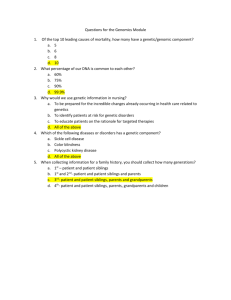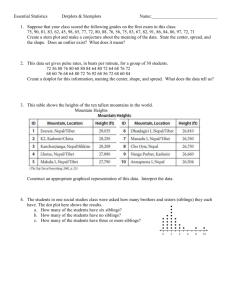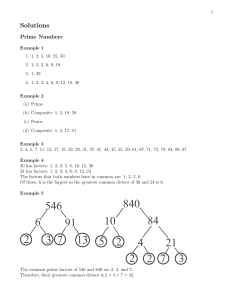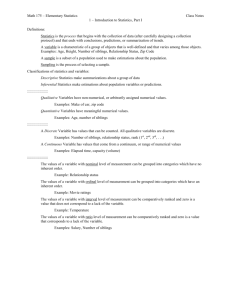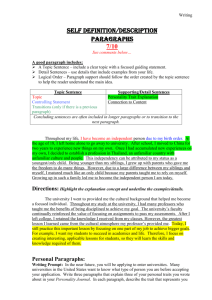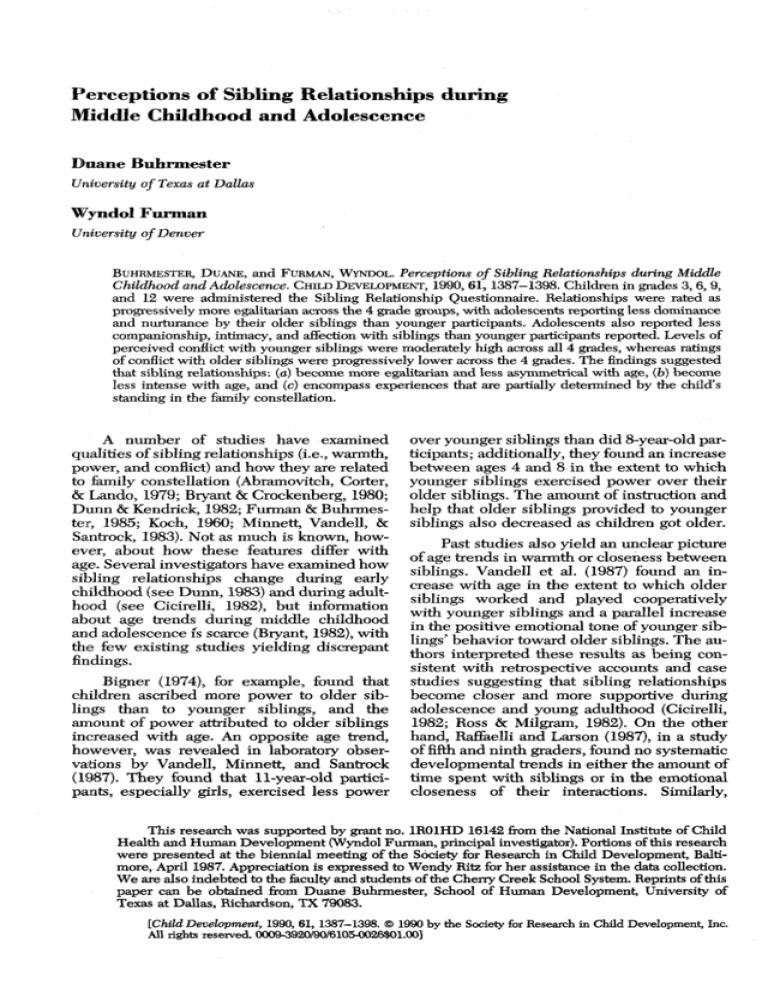
Perceptions of Sibling Relationships during
Middle Childhood and Adolescence
Eluane Buhrmester
University of Texas at Dallas
Wyndol Furman
University of Denver
BUHRMESTER, DUANE, and FURMAN, WYNDOL. Perceptions of Sibling Relationships during Middle
Childhood and Adolescence. GHILD DEVELOPMENT, 1990, 61,1387-1398. Ghildren in grades 3, 6, 9,
and 12 were administered the Sibling Relationship Questionnaire. Relationships were rated as
progressively more egalitarian across the 4 grade groups, with adolescents reporting less dominance
and nurturance by their older siblings than younger participants. Adolescents also reported less
companionship, intimacy, and affection with siblings than younger participants reported. Levels of
perceived conflict with younger siblings were moderately high across all 4 grades, whereas ratings
of conflict with older siblings were progressively lower across the 4 grades. The flndings suggested
that sibling relationships: (o) become more egalitarian and less asymmetrical with age, (fc) become
less intense with age, and (c) encompass experiences that are partially determined by the child's
standing in the family constellation.
A number of studies have examined
qualities of sibling relationships (i.e., warmth,
power, and conflict) and how they are related
to family constellation (Abramovitch, Gorter,
& Lando, 1979; Bryant & Grockenberg, 1980;
Dunn & Kendrick, 1982; Furman & Buhrmester, 1985; Koch, 1960; Minnett, Vandell, &
Saintrock, 1983). Not as much is known, however, about how these features differ with
age. Several investigators have examined how
sibling relationships change during early
childhood (see Dunn, 1983) and during adulthood (see Gicirelli, 1982), but information
about age trends during middle childhood
and adolescence is scarce (Bryant, 1982), with
the few existing studies yielding discrepant
findings.
Bigner (1974), for example, found that
children ascribed more power to older siblings than to younger siblings, and the
amount of power attributed to older siblings
increased with age. An opposite age trend,
however, was revealed in laboratory observaidons by Vandell, Minnett, and Santrock
(1987). They found that 11-year-old participants, especially girls, exercised less power
over younger siblings than did 8-year-old participants; additionally, they found an increase
between ages 4 and 8 in the extent to which
younger siblings exercised power over their
older siblings. The amount of instruction and
help that older siblings provided to younger
siblings also decreased as children got older.
Past studies also jdeld an unclear picture
of age trends in warmth or closeness between
siblings. Vandell et al. (1987) found an increase with age in the extent to which older
siblings worked and played cooperatively
with younger siblings and a parallel increase
in the positive emotional tone of younger siblings' behavior toward older siblings. The authors interpreted these results as being consistent with retrospective accounts and case
studies suggesting that sibling relationships
become closer and more supportive during
adolescence and young adulthood (Gicirelli,
1982; Ross & Milgram, 1982). On the other
hand, Raffaelli and Larson (1987), in a study
of fifth and ninth graders, found no systematic
developmental trends in either the amount of
time spent with siblings or in the emotional
closeness of their interactions. Similarly,
This research was supported by grant no. lROlHD 16142 from the National Institute of Ghild
Healdi and Human Development (Wyndol Furman, principal investigator). Portions of this research
were presented at the biennial meeting of the Society for Research in Ghild Development, Baltimore, April 1987. Appreciation is expressed to Wendy Ritz for her assistance in the data collection.
We are also indebted to the feculty and students of the Cherry Greek School System. Reprints of this
paper can be obtained from Duane Buhrmester, School of Human Development, University of
Texas at Dallas, Richardson, TX 79083.
[Child Development, 1990, 61, 1387-1398. © 1990 by the Society for Research in Child Development, Inc.
All rights reserved. 0009-392O/9O/6105-O026$01.00]
1388
Child Development
Buhrmester and Furman (1987) found no differences among second-, fifth-, and eighthgrade participants' ratings of companionship
with siblings.
Finally, it is unclear whether sibling relationships become more or less conflictual as
children grow older. Although Vandell et al.
(1987) expected a decrease in conflict during
middle childhood, they found that 11-yearolds engaged in more conflict with younger
siblings than 8-year-old children did. Raffaelli
and Larson (1987), on the other hand, expected to find an increase in conflict during
adolescence, but found no definitive developmental trends.
The primary purpose of the present study
was to clarify developmental trends in children's perceptions of the qualities of sibling
relationships. We gathered ratings of children's perceptions of sibling relationships using the Sibling Relationship Questionnaire
(SRQ) (Furman & Buhrmester, 1985). The
SRQ assesses 15 qualitative features of relationships that together capture the major
dimensions of sibling relationships (i.e.,
warmth/closeness, relative power/status, conflict, and rivalry).
A secondary purpose of the study was to
attempt to replicate and extend previous findings concerning associations between constellation status (i.e., age spacing, relative age,
sex, and sex of siblings) and relationship qualities. Specifically, several investigators have
found that the balance of power in relationships is strongly related to the relative age of
the sibling, with subjects whose siblings are
older than themselves reporting less power
than subjects whose siblings are younger
(Bigner, 1974; Bragg, Ostrowski, & Finley,
1973; Furman & Buhrmester, 1985; Minnett
et al., 1983). The warmth or closeness of relationships has also been found to vary with
gender composition, with same-sex siblings
reporting greater warmth/closeness than opposite-sex dyads (Bowerman & Dobash, 1974;
Dunn & Kendrick, 1982; Furman & Buhrmester, 1985). Finally, the extent of confiict in the
relationship has been found to be greater
when the age spacing between siblings is narrow rather than wide (Furman & Buhrmester,
1985; Koch, 1960; Minnett et al., 1983).
Method
Subjects
Participants were 106 third graders (68
girls and 38 boys), 112 sixth graders (52 girls
and 60 boys), 85 ninth graders (39 girls and 46
boys), and 60 twelfth graders (33 girls and 27
boys). Average ages were 8-4, 11-4, 14-4, and
17-5, respectively.
The participants attended suburban public schools in Denver, Golorado, which
served predominantly Gaucasian children of
middle- and upper-middle-class families. Not
surprisingly, the number of siblings varied
somewhat across the four grades, F(3,387) =
6.90, p < .001 (M = 1.54, 1.76, 1.66, 2.23,
respectively). Mean ages of participants' older
and younger siblings are presented in Table 2.
Measures
The Sibling Relationships Questionnaire
(SRQ) consists of 15 scales (see Table 1), each
containing three items. Each item asks how
characteristic of the relationship a particular
feature is. A five-point Likert-type format (1
= hardly at all, 2 = not too much, 3 = somewhat, 4 = very much, 5 = extremely much) is
used for all scales except the parental partiality scale. In that case, response choices range
from "1 = almost always him/her [favored]"
to "5 = almost always me [favored]," with a
midpoint of "3 = about the same."
Intemal consistency coefficients (Gronbach alpha) computed separately for each of
the four grade levels were .71, .79, .77, and
.81, respectively. Of the 60 alpha coefficients
that were computed, all were greater than .60
except those for the following five scales:
third graders' competition (.57) and admiration towEird sibling (.57); ninth graders' nurturance by sibling (.54); and twelfth graders'
nurturance toward sibling (.53) and nurturance by sibling (.55). In other research, children's perceptions of these qualities have
been found to be moderately to strongly correlated with reports by other family members
(Furman, Jones, Buhrmester, & Adler, 1989).
Procedures
Questionnaires were administered to
groups of children at schools in a testing session lasting 20—30 min. Siblings' names were
written on each child's SRQ so he or she
could easily keep track of who was being
rated. Questions were read aloud to third and
sixth graders. For the purposes of this report,
scores for only one sibling relationship were
selected for analysis. Selections were made so
as to achieve an approximately equal distribution of subjects in the different combinations
of the following variables: sex of subject, sex
of sibling, relative age of sibling (older/
younger), and the age spacing between the
subject and sibling (less than 4 years vs. 4 or
more years). The criterion of 4 years differ-
Buhrmester and Furman
ence in age was selected because it permitted
the most equal division of subjects.
Results
In order to limit the number of chance
findings, three multivariate analyses of variance (MANOVA) were conducted on sets of
conceptually related scales assessing the general dimensions of warmth/closeness, relative
power, and conflict as identified by Furman
and Buhrmester (1985).^ The scales included
in each MANOVA are grouped together as
shown in Table 1. The independent variables
in the analyses were grade, sex, sibling sex,
relative age (i.e., the sibling is older or younger than the participant), and sibling spacing
(4 or less years vs. more than 4 years difference). Univariate analyses were conducted
when the corresponding multivariate efifect
was significant (see Table 1). Follow-up analyses used Newman-Keuls tests with .05 alpha level. The significant MANOVA effects
are reported in the text, whereas Table 1 summarizes the significant univariate effects.
Means and standard deviations broken down
by grade level and by subjects' ratings of
older and younger siblings are presented in
Taible 2.
Relative Power/Status
Grade differences.—The MANOVA of
the four scales reflecting status/power revealed a main effect of grade, F(12,759) =
3.39, p < .001, which was qualified by a grade
X relative age interaction, F( 12,759) = 6.02,
p < .001. Follow-up ANOVAs yielded main
eflects of grade for all scales except dominance over sibling; grade x relative age interactions were also found for all four scales.
In general, the findings Were consistent
with the results of Vandell et al. (1987), but
contrary to those of Bigner (1974). That is,
grade differences in nurturance by sibling
were found for subjects who had older siblings. Subjects in grade 3 reported being most
nurtured by older siblings, whereas subjects
in grades 9 and 12 reported being least nurtured; scores for grade 6 fell in between those
for grades 3 and 9. Interestingly, subjects' ratings of nurturance of younger siblings were
moderately high across grade 3 to grade 9,
wiith only twelfth graders reporting significantly lower levels of nurturance directed toward younger siblings. Not surprisingly, sub-
1389
jects' reports of being nurtured by younger
siblings, as well as reports of nurturing older
siblings, were infrequent and varied litde
across the four grade levels.
At first glance, the different developmental trends for subjects' ratings of nurturance by older siblings and nurturance of
younger siblings would seem to indicate a
discrepancy between earlier- and later-bom
subjects' perceptions of the age at which nurturemce decreased. For earlier-borns' ratings
of relationships with younger siblings, the decline occurred between grade 9 and grade 12,
whereas later-boms' ratings of relationships
with older siblings declined between grade 3
and grade 6. It should be noted, however, that
later-boms' ratings of nurturance by older siblings described relationships with siblings
who were on the average 4 years older than
themselves, whereas earlier-boms' ratings of
nurturance of younger siblings described siblings who were on the average 4 years younger than themselves. When the age of the sibling being rated is considered, we found that
there was general agreement in reports of
nurturance (see Fig. 1). Perceived nurturance
declined most rapidly when younger members of dyads were on average between 10
and 15 years old and older members of dyads
were on average between 14 and 19 years old.
Similar age trends were evident for dominance ratings. At each successive grade level
later-boms reported being dominated less by
their older siblings. Later-boms' ratings of
dominance over older siblings and earlierborns' ratings of dominance by younger siblings were low and varied modestly across the
four grades, with only third graders' ratings of
dominance over older siblings being significantly higher than all other grade levels.
Taken together, these findings indicate that as
children grow older, they perceive that older
brothers and sisters exercise less power/status
over younger ones, whereas the power/status
of the younger sibling is perceived as remaining relatively low.
Constellation effects.—As expected, the
MANOVA revealed a large main effect of relative age for the scales assessing aspects of
power/status, F(4,251) = 132.50, p < .001.
Consistent with past findings (Bigner, 1974;
Furman & Buhrmester, 1985; Sutton-Smith &
Rosenberg, 1970), subjects perceived older
^ Although Furman and BuhrmestEr (1985) found that the Parental Partiahty Scale loaded on a
fotirth factor labeled "Rivalry," they noted that this was an underidentifled factor that was moderately correlated with the conflict dimension. Therefore, Parental Partiality scores were grouped with
the scales reflecting conflict in the current analyses.
TABLE 1
SUMMARY OF SIGNIFICANT ANOVA EFFECTS
Variable and Effect
Relative status/power scales:
Nurturance by sib:
Grade
Relative age
F
Description
10.20
323.40
Grade x relative age
23.04
Relative age x age spacing
17.59
Grade 3 (2.60) greater than all other grades
(2.12).
Subjects nurtured more by older (2.98) than by
younger sibs (1.55).
Decreases with grade when sibs are older:
grade 3 greater than grade 6, which is
greater than grades 9 and 12. No grade
differences when sibs are younger (see Table 2).
Nurturance by wide-spaced older sibs (3.08)
greater than by narrow-spaced older sibs
(2.68), which was greater than nurturance by
younger sibs (1.55).
Nurturance of sib:
Grade
Relative age
Grade x relative age
Relative age x age spacing
3.43
223.43
4.04
19.73
Dominance by sib:
Grade
5.40
Relative age
122.77
Age spacing
4.04
Grade x relative age
2.75
Dominance over sib:
Relative age
148.33
Age spacing
6.74
Grade x relative age
4.64
Warmth/closeness scales:
Intimacy:
Grade
3.95
Relative age
19.96
Age spacing
4.00
Sib sex X relative age
Sex X sib sex
10.26
6.16
Grade 12 (2.26) less than all other grades
(2.76).
Subjects more nurturant of younger (3.31) than
older sibs (1.98).
Grade 12 less than all other grades when sib
is younger; no grade difference when sib is
older (see Table 2).
Nurturance toward wide-spaced younger sibs
(3.58) greater than by narrow-spaced younger sibs (2.97), which was greater than nurturance toward older sibs (1.98).
Grade 3 (2.60) greater than all other grades
(2.39).
Subjects dominated more by older (2.94) than
by younger sibs (1.82).
Subjects dominated more by narrow-spaced
(2.53) than wide-spaced sibs (2.27).
When sib is older, significant decreases between each successive grade. When sib is
younger, only grade 3 greater than grade
6, with no other grade differences (see Table 2).
Subjects more dominant over younger (3.04)
than older sibs (1.80).
Subjects more dominant over narrow-spaced
(2.57) than wide-spaced sibs (2.33).
Grade 3 is greater than all other grades when
sibs are older. No grade difference when
sibs are younger (see Table 2).
Grades 3 (3.05) greater than all other grades
(2.58).
Subjects more intimate with older (3.00) than
younger sibs (2.43).
Subjects more intimate with narrow..spaced
(2.88) than wide-spaced sibs (2.58).
Subjects more intimate with older sisters
(3.23) than all other sibs (2.59).
Girls more intimate with sisters (3.03) than
brothers (2.60); no signiflcant difference between sisters (2.53) and brothers (2.71) for
boys.
1390
TABLE 1 (CONTINUED)
Variable and Effect
F
Description
Affection:
Grade
Age spacing
Sib sex X relative age
2.78
10.70
2.95
Prosocial behavior:
Age spacing
3.77
Sib sex X relative age
3.96
Grade 3 (4.12) greater than all other grades
(3.77).
Subjects more affectionate with wide-spaced
(4.02) than narrow-spaced (3.73) sibs.
Subjects more affectionate with older sisters
(4.01) than all other sibs (3.80).
Subjects more prosocial with wide-spaced
(3.42) than narrow-spaced (3.25) sibs.
Subjects more prosocial with older sisters
(3.54) than all other sibs (3.28).
Grade 3 (3.63) greater than grade 6 (3.31),
which is greater than grade 9 (3.01), which
is greater than grade 12 (2.51).
For girls, more companionship with sisters
(3.48) than brothers (3.12); for boys, no
signiflcant difference between sisters (2.90)
and brothers (3.26).
Gompanionship:
Grade
Sex X sib sex
16.88
14.05
Similarity:
Sex X sib sex
10.82
Girls feel more similar to sisters (3.22) than
brothers (2.83); for boys, no significant difference between sisters (2.64) and brothers
(3.06).
Admiration by sib:
Sex X sib sex ..
3.74
Girls feel more admired by sisters (3.64) than
by brothers (3.37); for boys, no signiflcant
difference between sisters (3.42) and
brothers (3.55).
Admiration of sib:
Grade
2.68
Grade 3 (3.77) greater than grade 6 (3.39) and
grade 9 (3.45); grade 12 (3.68) not different
from grades 3, 6, and 9.
Subjects admire older sibs (3.79) more than
younger sibs (3.33).
Subjects admire wide-spaced sibs (3.62) more
than narrow-spaced sibs (3.49).
Relative age
21.64
Age spacing
3.58
Gonflict/rivalry scales:
Quarreling:
Relative age
Age spacing
Grade x relative age
Antagonism:
Grade
13.86
15.40
2.64
2.65
Relative age
10.35
Age spacing
12.41
Grade x relative age
3.91
1391
Subjects quarreling more with younger (3.14)
than older sibs (2.69).
Subjects quarreling more with narrow-spaced
(3.15) than wide-spaced sibs (2.71).
When sibs are older, grade 3 is greater than
grade 12. No grade differences when sibs
are younger (see Table 2).
Grade 3 (2.88) greater than grade 12 (2.44);
grade 6 (2.63) and grade 9 (2.60) not different from grades 3 or 12.
Subjects report more antagonism with younger
(2.84) than older sibs (2.48).
Subjects report more antagonism with narrowspaced (2.86) than wide-spaced sibs (2.50).
Decreased with grade when sibs are older:
grade 3 greater than grades 9 and 12, and
grade 6 greater than grade 12. No grade
difference when sibs are younger (see Table 2).
1392
Child Development
TABLE 1 (CONTINUED)
Variable and Effect
Gompetition:
Grade
Description
10.04
Age spacing
6.29
Grade x relative age
2.70
Parental partiality for sib:
Relative age
14.38
Grade 3 (3.09) greater than grade 9 (2.48) and
grade 12 (2.44); grade 6 (2.63) greater than
grade 12 but not grades 3 or 9.
More competition with narrow-spaced (2.80)
than wide-spaced (2.55) sibs.
Effect of grade holds only when sibs are older
(see Table 2).
Subjects report greater partiality for sib when
sib is younger (2.69) than when sib is older
(3.00).
NOTE.—Relative age = relative age of sibling and subject; age difference = absolute difference in age between
siblings (less than 4 years vs. 4 or more). Values in parentheses are means of relevant cells. Degrees of freedom for F's
are 1 and 270, except for effects involving grade, where they are 3 and 270. All F's and follow-up comparisons reported
in the table are significant at the .05 level.
siblings as more domineering and nnrturing
than younger siblings. Similarly, subjects reported directing more dominance and nurturance toward younger siblings than toward
older ones.
The MANOVA also revealed main effects for sibling spacing, F(4,251) = 2.36, p <
.001, with the ANOVAs showing that greater
dominance over siblings, as well as dominance by siblings, were reported in closely
spaced rather than widely spaced sibling
pairs. The MANOVA also revealed a relative
age X age spacing interaction, F(4,251) =
7.73, p < .001, with greater nurturance of
younger siblings reported when pairs were
widely rather than narrowly spaced.
Warmth/C loseness
Grade differences.—The MANOVA for
the set of warmth/closeness scales revealed a
main effect of grade, F(21,732) = 3.16, p <
.001. Univariate ANOVAs found grade effects
for four of seven of the scales. Companionship
ratings showed the most noteworthy grade
differences: third graders reported the highest
levels of companionship; scores for each subsequent grade level were significantly lower
than the previous one. Twelfth graders reported less affection, intimacy, nurturance by
siblings, and admiration toward siblings than
younger students, with the differences between grade 3 and grade 6 accounting for
most of the grade effect. Thus, contrary to the
views of several authors (Cicirelli, 1982; Ross
& Milgram, 1982), older subjects reported
feeling more distant from siblings than younger ones. Adolescents reported spending considerably less time engaging in enjoyable activities with siblings and felt slightly less
warm toward siblings than did younger subjects.
Constellation effects.—Counter to expectations, the MANOVA did not yield a
significant sex X sibling sex interaction,
F(9,277) = 1.77, p > .13. In order to explore
whether the findings reported by other investigators would nonetheless replicate for individual scales, univariate findings were examined. Consistent with previous findings, the
ANOVAs revealed significant sex X sibling
sex interactions for the intimacy, companionship, similarity, and admiration by sibling
scales. In each case, girls rated sisters significantly higher than brothers, whereas there
was a nonsignificant trend in the direction of
boys rating brothers higher than sisters.
These results partially replicate previous
findings (Furman & Buhrmester, 1985), showing that there was a tendency for girls, at least,
to feel more positive toward same-sex sibling.
The MANOVA also revealed a main effect for the spacing between siblings among
the scales reflecting closeness/warmth,
F(7,242) = 3.05, p < .01. Follow-up ANOVAs
showed that children reported greater affection, prosocial behavior, and admiration of
siblings who were more than 4 years different
in age than more closely spaced siblings. The
interesting exception to this general trend
was that subjects reported greater intimacy
^vith siblings who were less than 4 years different in age.
Finally, the MANOVA revealed a main
effect of relative age, F(7,242) = 6.50, p <
.001, which was qualified by a relative age x
sibling sex interaction, F(7,242) = 2.37, p <
TABLE 2
AGES OF SIBLINGS AND MEANS AND STANDARD DEVIATIONS OF SRQ RATINGS
Grade
3
Average ages of siblings
(in years):
Younger sibling
Older sibling
Relative status/power
scales:
Nurturance by sibling:
Younger
Older
Nurturance of sibling:
Younger
Older
Dominance by sibling:
Younger
Older
Dominance over sibling:
Younger
Older
Warmth/closeness scales:
Intimacy:
Younger
Older
Affection:
Younger
Older
Prosocial behavior:
Younger
Older
Gompanionship:
Younger
Older
Similarity:
Younger
Older
Admiration by sibling:
Younger
Older
Admiration of sibling:
Younger
Older
Gonflict/rivalry scales:
Quarreling:
Younger
Older
Antagonism:
Younger
Older
Competition:
Younger
Older
Parental partiality for
sibling:
Younger
Older
4.51 (3.93)
13.46(2.38)
6
9
12
7.30 (3.20)
17.16(3.60)
10.21 (4.71)
19.11(3.23)
14.20 (3.97)
23.33(5.57)
1.4r(.5O)
3.89" (1.09)
1.48^ (.52)
2.87'' (.91)
1.69" (.59)
2.45" (.68)
1.75" (.55)
2.45° (.66)
3.36" (.99)
2.18" (1.02)
3.56" (.75)
1.77" (.57)
3.31" (.84)
2.06" (.65)
2.68''(.73)
1.91" (.60)
2.03" (1.00)
3.40" (1.23)
1.60''(.68)
3.00''(1.13)
1.86"''(.76)
2.77° (1.15)
1.83"''(.63)
2.34'' (.99)
2.92" (1.31)
2.24" (.90)
3.17" (.99)
1.71'' (.90)
2.98" (.80)
1.70'' (.67)
3.12" (.81)
1.44'' (.47)
2.87" (1.20)
3.25" (1.22)
2.33''(1.08)
2.92'' (1.32)
2.11''(1.02)
2.86'' (1.52)
2.31''(1.08)
2.96'' (1.18)
4.23" (.78)
3.99" (.97)
3.90''(.78)
3.75''(1.02)
3.67''(.80)
3.79''(1.14)
3.44''(.80)
4.12''(.80)
3.49 (.90)
3.52 (1.19)
3.28 (.81)
3.44 (1.01)
3.18 (.72)
3.30 (1.09)
2.96 (.88)
3.38 (.90)
3.60" (.96)
3.67" (.99)
3.38''(.83)
3.24''(1.05)
2.87''(.85)
3.17''(1.19)
2.45''(.95)
2.55''(1.27)
3.04 (.91)
2.74 (1.02)
2.87 (.89)
3.03 (.95)
2.78 (.95)
2.87 (1.05)
3.08(1.07)
3.24 (1.06)
3.56(1.09)
3.51(1.25)
3.58 (.66)
3.32(1.06)
3.60 (.80)
3.32(1.19)
3.59 (.82)
3.49 (.88)
3.61" (1.00)
3.93" (.93)
3.17" (.90)
3.60''(.94)
3.21" (.80)
3.71''(1.11)
3.32"''(.86)
3.98"''(.81)
3.07" (1.18)
2.99" (1.20)
3.04" (1.12)
2.73"'" (1.20)
3.27" (.89)
2.74"'' (1.10)
3.24" (.99)
2.10'' (.98)
2.80" (1.19)
2.96" (1.26)
2.73" (1.04)
2.51"'' (1.10)
2.89" (.78)
2.26''° (1.10)
3.03" (.96)
1.97° (1.02)
2.87" (1.17)
3.31" (1.09)
2.75" (.99)
2.51"''(1.10)
2.52" (.97)
2.44''(.97)
2.40" (.88)
2.10° (1.06)
2.79 (.75)
3.07 (.81)
2.72 (.66)
2.99 (.54)
2.56 (.74)
2.91 (.65)
2.64 (.85)
3.04 (.77)
NOTE.—Superscripts indicate results of post hoc comparisons made across the four grades; means with different
superscripts are significantly different.
1394
Child Development
4.5-1
LATER-BORN S's RATINGS OF
NURTURANCE BY OLDER SIBS
EARLIER BORN S's RATINGS OF
NURTURANCE OF YOUNGER SIBS
4.0-
LATER-BORN S's RATINGS OF
NURTURANCE OF OLDER SIBS
EARLIER-BORN S's RATINGS OF
NURTURANCE BY YOUNGER SIBS
UJ
O
Z 3.5CC
3
3.0O
NURTURANCE GIVEN TO
YOUNGER SIBS
CD
P 2.5
2.0-
.-lorr-—•
1.5-
NURTURANCE GIVEN TO
OLDER SIBS
1.0
5
6
7
8
9
10
11
12
13
14
15
16
17
18
MEAN AGE OF YOUNGER SIBLING IN DYAD
FIG. 1.—Ratings of nurturance plotted according to the average ages of younger siblings in dyads
.05. The ANOVAs showed that greater admiration of siblings was reported when siblings
were older rather than younger. Subjects also
reported greater intimacy, afifection, and prosocial behavior with older sisters than with
older brothers or younger siblings of either
sex.
more than 4 years apart in age were seen as
less conflictual than those with siblings less
than 4 years apart in age. Subjects reported
less quarreling, antagonism, and competition
with wide-spaced siblings and more dominance by and over narrow-spaced siblings.
Conflict/Rivalry
Grade differences.—The MANOVA for
the scales reflecting conflict and rivalry revealed a main effect of grade, F(9,801) = 4.36,
p < .001, which was qualifled by a signiflcant
grade x relative age interaction, F(9,801) =
2.71, p < .05. Contrary to Vandell et al.'s
(1987) flndings of increased conflict during
middle childhood, the ANOVAs revealed
that twelfth graders reported considerably
less quarreling, antagonism, and competition with older siblings than third graders,
and that these developmental trends were
gradual. Reports of quarreling, antagonism,
and competition w^ith younger siblings were
moderately high and did not vary across the
four grades.
The MANOVA also revealed a main effect of relative age, F(3,265) = 4.16, p < .01.
Follow-up ANOVAs showed that greater parental partiality, quarreling, and antagonism
were reported with younger than with older
siblings. It was possible, however, that the
effects of relative age for the latter two scales
were merely artifacts of the grade-related decline in quarreling and antagonism described
previously. That is, we would expect subjects
to report less conflict with older siblings than
younger siblings because their older siblings
are further along the developmental continuum and therefore less likely to quarrel
with them. Figure 2 reveals, however, that
when the ages of the siblings are considered
in the ratings of antagonism with younger and
older siblings, a discrepancy still remains.
This discrepancy was most apparent when
the older member of the dyad averaged 14
years old and the younger member of the
dyad averaged 18 years old. At this point,
later-born subjects' ratings of antagonism with
older siblings are approximately three-quarters of a scale point lower than earlier-bom
Constellation effects.—The MANOVA
revealed a main effect of the age spacing between siblings, F(3,265) = 5.71, p < .001.
Consistent with flndings from past studies
(Furman & Buhrmester, 1985; Koch, 1960;
Minnett et al., 1983), the ANOVAs showed
that relationships with siblings who were
Buhrmester and Furman
^
1395
3.5ANTAGONISM WITH
YOUNGER SIBLING
I 3.o^
u.
O
CD
P 2-5CC
z
a 2.0ANTAGONISM WITH
OLDER SIBLING
6
7
8
9
10
11
12
13
14
15
16
17
18
MEAN AGE OF YOUNGER SIBLING IN DYAD
FIG. 2.—Ratings of antagonism plotted according to the average ages of younger siblings in dyads
subjects' ratings of antagonism with younger
siblings. These flndings indicate that relationships with younger siblings are generally perceived as less harmonious and warm than
tliose with older siblings.
Diseussion
When the current flndings are considered
in conjunction with results from other studies
of sibling relationships, three tentative generalizations about the developmental cotirse of
sibling relationships emerge. First, significant
transformations occur in the power/status
structure of sibling relationships wherein relationships become more egalitarian and less
asymmetrical with age. Across the four grades
studied, there were noteworthy decreases in
thie extent of nurturance and dominance perceived to be directed toward younger siblings. These trends can probably be traced to
age-related changes in the developmental
status of the individual children in the dyads.
Tbe current flndings indicate that the bulk of
this transformation is complete by the time
younger siblings are roughly 12 years old, the
age at which children typically show a reasonable amount of self-sufficiency and no
longer need continuous supervision. Thus, as
later-born siblings grow older, they become
more competent and independent, thereby
requiring and accepting less nurturance and
direction from older siblings. At the same
time, the relative difference in developmental
status between older and younger siblings diminishes as children get older. For example, a
3-year-old child is vastly more competent
than his or her newborn younger sibling (in
terms of physical, social, and cognitive capabilities), but, by the time these siblings are 21
and 18 years old, respectively, they will be
virtually equal in competence. In sum, as siblings grow more competent and their developmental statuses become similar, their relationships become more symmetrical and
egalitcirian.
This developmental trend parallels, to
some degree, the change in authority structure that takes place in peirent-child relationships during adolescence (Youniss, 1980;
Youniss & Smollar, 1985). If anything, the
changes in the distribution of power in sibling relationships may precede those in parent-child relationships. Such would be expected if these changes reflect a convergence
in the competence of the members of dyads.
That is, even during adolescence, the difference in the competence and status of parent
and child would be expected to be greater
than that between two siblings.
The changes that occur in sibling relationships, however, are unique in at least one
important respect: children's experiences
with siblings differ greatly depending on
whether they are older or younger siblings.
Older siblings inherit positions of authority
and responsibility that they never hold in
their relationships with parents and peers. As
they grow up, older siblings are faced with
relinquishing power/status, whereas younger
siblings acquire a more equal footing. Additional research is needed to explore the dynamics of this transformation in power/status
1396
Child Development
and to determine whether it has signiflcant
consequences for child development.
Second, as children grow older, their
sibling relationships typically become less
intense. Ratings of every major dimension
of sibling relationships dropped ofl^ to some
degree with age, including the exercise of
power, the warmth/closeness of relationships,
and the extent of reported conflict. This trend
can partially be traced to the decreasing
amount of interaction among siblings as they
grow older. In fact, the most pronounced age
trend among the warmth/closeness scales was
found for companionship, with ratings for
twelfth graders being over a full standeurd deviation lower than those for third graders.
Data from other studies corroborate this
flnding. During the preschool years, siblings
spend the vast majority of their time in the
presence of each other (Ellis, Rogoff, &
Cromer, 1981), but by the time siblings are
adolescents, they spend a relatively small
fraction of their time together (Raffaelli & Larson, 1987). This decreasing rate of interaction
undoubtedly affects the frequency of both
positive and negative interactions.
Although the changing social ecologies
of childhood and adolescence may partially
account for decreasing rates of sibling interaction, they may also reflect the psychological
transition from dependence on family to investment in peer relationships (Buhrmester &
Furman, 1987; Ftirman & Buhrmester, 1989).
Adolescents may want to spend less time
with siblings who are part of the family from
whom they want to develop some autonomy.
In addition, as adolescents become more involved in intimate friendships and romantic
relationships, they have less time and perhaps
less socioemotional need to invest in relationships with siblings. It is important, however,
not to overstate the degree to which sibling
relationships become more distant with age.
There were, in fact, relatively modest agerelated decrements in ratings of intimacy, affection, and admiration (amounting to less
than one-half standard deviation difference
over the age-range studied). Thus, the emotional attachment between siblings remains
moderately strong throughout adolescence,
despite the decline in companionship (Weiss,
1974). Moreover, our examination of group
averages undoubtedly masked important variations in the developmental course of sibling
relationships. Some sibling relationships may
become supportive egalitarian friendships
during adolescence, whereas others may become distant.
Third, the course of experiences with siblings is partially determined by the child's
status in the family constellation. The most
influential aspect of constellation status is the
child's position of being the older or younger
member of the dyad. Younger siblings have
experienced being nurtured and dominated,
whereas older siblings are nurturant and
dominating. The size of the effects associated
with relative age was very large for the dominance and nurturance scales, indicating that
relative age of the two siblings accounted for
the vast majority of variance in these scores.
Although the strength of these effects diminished substantially with age (as indicated
above), it seems clear that being an older versus younger sibling during early childhood is
associated with markedly different experiences.
There also appears to be a basic asymmetry in the sentiments that older and younger siblings feel for one another. For instance,
there is a discrepancy between older and
younger siblings' perceptions of conflict:
later-born subjects reported that conflict with
older siblings dropped ofF steadily with age,
whereas earlier-bom subjects' ratings did not
evidence a parallel decline in conflict with
younger siblings (see Fig. 2). In addition to
less conflict with older siblings, later-bom
subjects reported greater admiration for and
intimacy with older siblings than earlier-bom
subjects report toward younger siblings. It appears as if younger siblings look up to and
value interacting with older brothers and sisters, whereas older siblings view younger siblings as an annoyance. This asymmetry in
sentiments may be part of a separation and
individuation stmggle in which earlier-bom
adolescents try to distance themselves from
the family, whereas the later-bom children try
to be "more grown up" by identifying with
the greater autonomy of older siblings. This
interpretation is speculative, of course, but
deserves exploration in future research.
Other constellation variables also affect
the course of sibling relationships, but to a
lesser degree. In general, wider spacing between siblings tends to foster more facilitative
relationships than narrower spacing, with
\vider spacing associated with more nurturance, prosocial behavior, and affection and
narrower spacing associated with greater
quarreling, antagonism, and dominance. In
addition, the gender composition of the dyad
affects the warmth/closeness of these relationships. Cenerally, same-sex siblings feel closer
than opposite-sex siblings. It is important to
Buhrmester and Furman
note, however, that although these constellation effects have now been replicated across
several studies, they generally account for a
rather modest amount of the variance in sibling relationships (with relative age being
thie noteworthy exception). In fact, Stocker,
Dunn, and Plomin (1989) recently demonstrated that child temperament, matemal behavior, and child age accounted for more of
the variance in the quality of sibling relationships than did family structure variables.
In addition to the three foregoing generalizations, we also put forth the following
hypothesis: The qualities of sibling relationships during the preschool and early
elementary years may be more influential in
shaping the distinctiveness of children's personalities than relationships during adolescence. This admittedly speculative contention is a logical derivative of the conclusions
sp)ecifled above, but it is not as yet grounded
in empirical flndings. Two related considerations suggest this hypothesis. First, it seems
likely that the influence of any relationship on
individual development is related to the
scope and intensity of that relationship. That
is, inasmuch as sibling relationships are more
intense during early childhood than adolescence, it follows that sibling relationships
should have their greatest effects on personalities and adjustment during early childhood.
Second, behavior geneticists have argued
that siblings may create different environments for each odier, thereby contributing to
the differences between them (Rowe & Plomin, 1981; Scarr & Grajek, 1982). It is our
view that "complementary" features of sibling relationships such as dominance and nurturance, in contrast to "reciprocal" features
like warmth and conflict, are likely to play
the greatest role in fostering dissimilarities
among siblings (see Dunn, 1983; Rowe & Plomin, 1981). Inasmuch as the current flndings
indicate that the greatest asymmetry in these
complementary features occurs in early childhood, it may be that sibling relationships contribute more to the development of dissimilarit)' during that time than during adolescence.
This possibility may help explain why Rowe
and Plomin (1981) found litde evidence using
a sample of adolescents that the qualities of
sibling relationships contributed to differences in siblings' personalities.
Limitations and Conclusions
Although the current data provide a more
complete picture of age differences in sibling
1397
relationships than previously available, several cautionary notes are in order. First, we
assessed children's perceptions of their relationships. Although there is evidence that
children's perceptions substantially agree
with the perceptions of parents and siblings
of their relationships (Furman et al., 1989),
their perceptions are not always veridical
with accounts of observed behavior. This
does not imply, however, that children's perceptions are less worthy of investigation (Olson, 1977). To the contrary, self-perceptions
of relationships may be psychologically important variables determining development
and psychosocial adjustment.
Second, the flndings indicate that sibling
relationships are affected in complex ways by
family constellation. Although we assessed
one of the largest cross-sectional samples examined to date, statistical power for sensitively detecting possible three-, four-, and
flve-way interactions is still lacking. Our results may capture the most pronounced age
and constellation effects but undoubtedly
miss more complex and subtler effects.
Finally, the current results provide a picture of age-related differences in sibling relationships but do not address issues concerning continuity and change over time.
Longitudinal studies are now Ccdled for to determine how siblings resolve issues during
development concerning power, conflict, and
dependency.
References
Abramovitch, R., Corter, C, & Lando, B. (1979).
Sibling interactions in the home. Child Development, 50, 997-^1003.
Bigner, J. A. (1974). Second-boms' discrimination
of sibling role concepts. Developmental Psychology, 10, 564-573.
Bowerman, C. E., & Dobash, R. M. (1974). Structural variations in inter-sibling affect. Journal
of Marriage and the Family, 36, 48-54.
Bragg, B. W. E., Ostrowski, M. V., & Finley, G. E.
(1973). The effects of birth order and age of
target on use of persuasive techniques. Child
Development, 44, 351-354.
Bryant, B. K. (1982). Sibling relationships in middle
childhood. In M. E. Lamb & B. Sutton-Smith
(Eds.), Sibling relationships: Their nature and
significance across the Ufespan (pp. 87-121).
Hillsdale, NJ: Erlbaum.
Bryant, B. K., & Crockenberg, S. B. (1980). Correlates and dimensions of prosocial behavior: A
study of female siblings and their mothers.
Child Development, 51, 529-544.
1398
Child Development
Buhrmester, D., & Furman, W. (1987). The devel115—135). Amherst: University of Massachuopment of companionship and intimacy. Child
setts Press.
Development, 58, 1101-1113.
Rafifaelli, M., & Larson, R. W. (1987). Sibling inCicirelli, V. C. (1982). Sibling influence throughout
teractions in late childhood and early adolesthe lifespan. In M. E. Lamb & B. Sutton-Smith
cence. Paper presented at the biennial meeting
(Eds.), Sibling relationships: Their nature and
of the Society for Research in Child Developsignificance across the lifespan (pp. 267-284).
ment, Baltimore.
Hillsdale, NJ: Erlbaum.
Ross, H. G., & Milgram, J. I. (1982). Important variDunn, J. (1983). Sibling relationships in early childables in adult sibling relationships. In M. E.
hood. Child Development, 54, 787-811.
Lamb & B. Sutton-Smith (Eds.), Sibling relationships: Their nature and significance across
Dunn, J., & Kendrick, C. (1982). Siblings: Love,
the lifespan (pp. 123-152). Hillsdale, NJ: Erlenvy, and understanding. Cambridge, MA:
baum.
Harvard University Press.
Ellis, S., Rogoff, B., & Cromer, C. C. (1981). Age Rowe, D. C , & Plomin, T. (1981). The importance
segregation in children's social interactions.
of nonshared E^ environmental influence in
Developmental Psychology, 17, 399-407.
behavioral development. Developmental PsyFurman, W., & Buhrmester, D. (1985). Children's
chology, 17, 517-531.
perceptions of the qualities of sibling relation- Scarr, S., & Grajek, S. (1982). Similarities and differships. Child Development, 56, 448-461.
ences among siblings. In M. E. Lamb & B. SutFurman, W., & Buhrmester, D. (1989). Age difton-Smith (Eds.), Sibling relationships: Their
ferences in perceptions of social networks.
nature and significance across the life span
Unpublished manuscript. University of Den(pp. 357-381). Hillsdale, NJ: Erlbaum.
ver.
Stocker, C, Dunn, J., & Plomin, R. (1989). Sibling
Furman, W., Jones, L., Buhrmester, D., & Adler, T.
relationships: Links with child temperament,
(1989). Children's, parents', and observers' permatemal behavior, and family structure. Child
ceptions of sibling relationships. In P. G. ZuDevelopment, 60, 715-727.
kow (Ed.), Sibling interaction across culture Sutton-Smith, B., & Rosenberg, B. G. (1970). The
(pp. 163-180). New York: Springer-Verlag.
sibling. New York: Holt, Rinehart & Winston.
Koch, H. (1960). The relation of certain formal at- Vandell, D. L., Minnett, A. M., & Santrock, J. W.
tributes of siblings to attitudes held toward
(1987). Age differences in sibling relationships
each other and toward their parents. Monoduring middle childhood. Journal of Applied
graphs of the Society for Research in Child
Developmental Psychology, 8, 247-257.
Development, 25(4, Serial No. 78).
Weiss, R. S. (1974). The provisions of social relaMinnett, A. M., Vandell, D. L., & Santrock, J. W.
tionships. In Z. Rubin (Ed.), Doing unto others
(1983). The effects of sibling status on sibling
(pp. 17-26). Englewood Cliffs, NJ: Prenticeinteraction: Influence of birth order, age spacHall.
ing, sex of child, and sex of sibling. Child De- Youniss, J. (1980). Parents and peers in social development, 54, 1064-1072.
velopment: A Sullivan-Piaget perspective. ChiOlson, D. H. (1977). Insiders' and outsiders' views
cago: University of Chicago Press.
of relationships: Research studies. In G. Levin- Youniss, J., & Smollar, J. (1985). Adolescent relager & H. L. Raush (Eds.), Close relationships:
tions with mothers, fathers, and friends. ChiPerspectives on the meaning of intimacy (pp.
cago: University of Chicago Press.



